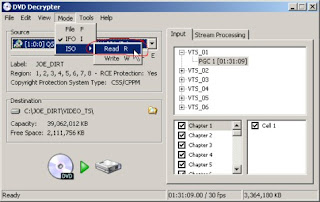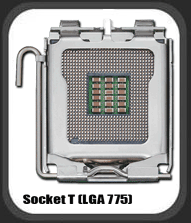Tuesday, September 23, 2008
Ass #1
1. A token ring is very effective under high sustained load, as no collisions can occur and each slot may be used to carry a message, providing high throughput. A token ring is less effective when the load is light (token processing takes longer than bus access, so any one packet can take longer to reach its destination), or sporadic.
Thursday, January 31, 2008
DVD recording
Step 1: Open the DVD with DVD Shrink
Download and install DVD Shrink.
Run DVD Shrink.
Insert the DVD you want to copy.
Select Open Disc . If you have more than one DVD drive, it will ask which one to use.

The program will analyze the disc. This can take many minutes.
Step 2: Removing Unwanted Features
This is a critical step. Since most DVDs are DVD-9 (8GB) and your blank disc is a DVD-5 (4.7GB) something has to go. Either you need to REMOVE things you don't want (like trailers or extras) and you will need to RECOMPRESS the video of the main movie to fit properly in the remaining space. If you remove something wrong, you can cause the resulting disc not to play right.
Here is the main screen you will see AFTER its done anayzing.
Here is the main screen you will see AFTER its done anayzing.
 Check to see if the recompression percentage is acceptable. Take a look at the percentage on the top right.
Check to see if the recompression percentage is acceptable. Take a look at the percentage on the top right.Make sure that you have MAIN MOVIE selected on the left . It should default to that, but double check.
Note: Some movies have TWO copies of the movie on the disc; widescreen and full screen. Typically, you will only want to keep one copy (hopefully the widescreen version). Before continuing, expand the MAIN MOVIE tree and make sure only ONE entry is there.
If there are two, and you want to keep BOTH, you will need to select each one in turn and follow the below steps for EACH entry.
Chances are likely, you only want ONE of them. DVD Shrink doesn't handle this easily at this time. I recommend you use Nero Recode instead. However, you can choose to replace the movie with still images and NO audio to get it the smallest possible.
See below REMOVING EXTRAS.
Remove Audio Tracks you to not want. Most of the time, there will be numerous audio tracks you do not need.
Remove Audio Tracks you to not want. Most of the time, there will be numerous audio tracks you do not need.

In this sample, we've unchecked EVERYTHING except the English track. You will likely see a very different list on your DVD. You might see a DTS track, several AC3 English tracks (not pointed out as Director Commentary), and several other languages. NORMALLY ... the biggest track in MB (in this case, 354MB) is the best one. If you have a DTS decoder on your home theater, you might ONLY select the DTS track. If you want to make sure it works on all machines, you might want to choose the DTS AND the first English audio track (normally AC3 5.1-ch English). The more you get rid of, the more room is available for the movie - the quality will go up.
Check to see if the recompression percentage is acceptable. (see above)
Remove subtitles. Subtitles are the words that you can turn on (like closed captions) during the movie that show what the actors are saying (or describing noises). Chances are likely you will want to remove them.

While you might be tempted to remove ALL subtitles, I recommend you leave English subtitles. If the movie has a section in a foreign language (like Klingon :), and the movie shows you, in English text on the bottom, the translation, the DVD might use subtitles to display these. Birthday Girl is a good example. If you remove the subtitles, the long scenes in Russian will not be translated for you.
Overcompress/Remove Extras. Many people don't care about extras like trailers, bloopers, featurettes, etc. To get that magic compression percentage up, you might want to overcompress/remove the extras to make MORE room for the movie. Note: If REMOVING extras is your plan, use the Nero Recode tutorial. You can, however, replace the extra with still frames with no audio
You can select each extra (as you can see, they aren't named) and use the preview window at the bottom to see what each extra is. You'll learn by the size (the more you do this) what is a trailer, what is a featurette, etc. Right now, the extra in our example is 184MB.
OVERCOMPRESSIONOnce you select an extra, the Video compression percentage will change, showing you how much DVD Shrink decided to recompress that extra. To make that extra smaller, you'll need to override the Video compression and choose a smaller value.
Change to CUSTOM RATIO, and move the slider to the lowest value. This will make that extra as small as it can be. Remember, you can also remove subtitles and audio tracks from these too (although its rare you will have that sort of option). After changing this to 50.7%, the size of the extra is now 160MB.
REMOVALYou can't really REMOVE the extra, but you CAN replace the whole movie with still blank images, remove ALL the audio and subpictures and make it VERY SMALL.

Change Video to STILL PICTURES. Uncheck all the Audio and Subpictures. You can now see that we've reduced the size to 34MB.
Step 3: The Backup Process
Choose where and how to burn the disc. If you have Nero installed, you can use the Nero engine to write the new DVD directly to your burner, or as an image file. If not, you need to at least select a new folder to put the DVD files.
Double check the other settings. Poke through the other tabs on the Backup window and make sure everything is how you want it.
Hit OK . This will start the process..
The encoder window will appear and show you the remaining time, a preview window, etc. This deprotects, compresses, and otherwise processes the DVD. This can take anywhere from 30 minutes to a couple hours (or more).
If you elected to burn the DVD directly in Nero, then the DVD will burn, and you are done. If not, you have one more chance to make sure the movie is good before you burn it.
I recommend that you always write the movie to the hard drive first (even if its just a Nero Image File - you can mount that as a DVD image and test it out later).
Step 4: Check and Burn The Movie
Load your favorite software and check out the movie. If its acceptable, use your favorite DVD software to write the files to a DVD-Video.
Wednesday, January 23, 2008
CPU Socket

Socket T (LGA 775):
Socket T actually doesn't mount to a socket like the rest of processors on this list, as the pins usually found on the processor have been moved to the motherboard, and the processor now receives the 755 pins on its underside. Socket T processors are basically the next generation of Celerons and Pentium 4s found on the Socket 478 format, continuing many of the same attributes, such as Hyper-Threading, on the Pentium 4 series.
The Celerons in Socket T only support a 533 MHz frontside bus (Celeron D), and the Pentium 4s support both an 800 MHz frontside bus and a new 1066 MHz (266 MHz x 4) frontside bus. Speeds of the processors can range from under 3 GHz while the high end of the speed scale has not yet been reached. Processors approaching 4 GHz are becoming available, and it will be interesting to see how fast this format will be able to climb.
As Intel transitioned to the LGA (Land Grid Array) 775 format, they also transitioned to a three digit naming convention, similar to the PR (Performance Rating) grades that AMD had used for years. Instead of simply marketing a 3.0 GHz Pentium 4 Prescott core as such, they now refer to it as the Pentium 4 530. A 2.8 GHz Prescott is now called a 520, and a 3.8 GHz Prescott is called a 570.
Socket 478:
For all of these form factors, the number following "socket" refers to the number of CPU pins or connectors. Socket 478 is a format specifically designed for Intel's Celeron, Pentium 4, and Mobile Celeron/Pentium processors.
This socket supports processors with frontside buses of 400 MHz (100 MHz x 4), 533 MHz (133 MHz x 4), and 800 MHz (200 MHz x 4), and provides top speeds from below 1 GHz to higher than 3 GHz. The Intel naming system used for the Pentium 4 processors in this class uses letters to represent the frontside bus speeds present. An "A" means 400 MHz, "B" means 533 MHz, and "C" means 800 MHz. So, a Pentium 4 2.4C would offer greater performance than a 2.4B or a 2.4A, despite them all having the same 2.4 GHz clock speed.The Pentium class of processors, like many others from AMD and Intel, also apply names to the "cores" present on the processor. The core is the processing portion of the CPU, generally found at the center of the silicon wafer. As the architecture within cores of the same type of processor change, new names are given to signify the different levels of performance that users may experience. The Northwood, Gallatin, and Prescott cores can be found on Pentium 4 processors of the same speed, and a main difference between the three is that the first two are fabricated on a 0.13 micron (one one-millionth of a meter) process and the Prescott is fabricated on a 0.09 micron process. A lower number implies a more tightly-packed core that generally requires less power to perform the same operations.
Socket 603/604:
These CPUs may not be as common as the others, but are worthy of inclusion on this list anyway. Socket 603 and Socket 604 are the home to Intel's modern Xeon processors, which are more likely to be found in a high-end server than in a desktop computer.
The Xeon can come with frontside buses ranging from 400 MHz (100 MHz x 4) to 800 MHz (200 MHz x 4), and provide top speeds that now reach 3.6 GHz. Socket 603 is for older, slower Xeons capable of a 400 MHz frontside bus, and Socket 604 adds the one pin simply to identify the faster bus speeds. Socket 603 processors will fit and function in a Socket 604 motherboard, but the opposite will not work.Xeons are powerful processors all on their own, but the architecture of the CPU and supporting motherboards allows for serious systems to be configured with dual processors, or perhaps even four processors, to really make light work of even the most intensive application.
Subscribe to:
Comments (Atom)







